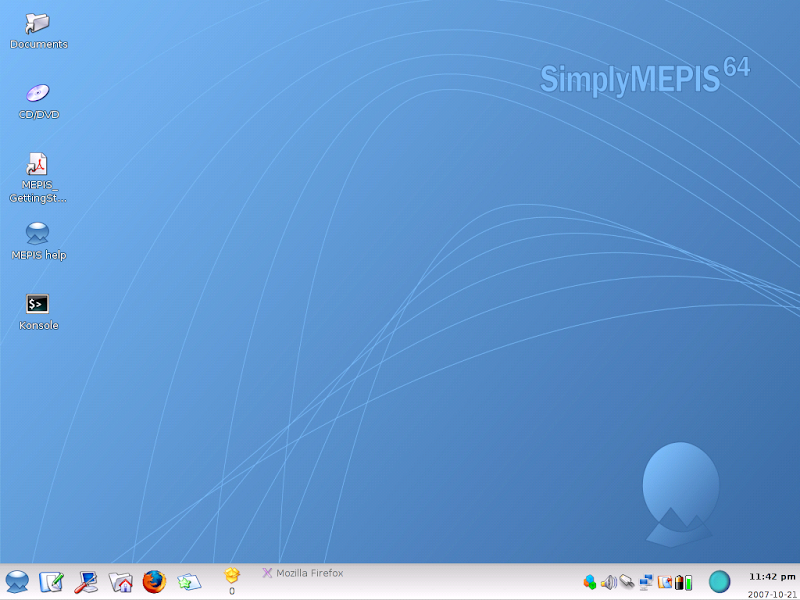Last week I wrote the first part of this series which discussed the installation of Mepis, Kubuntu, OpenSuse, and Freespire on my laptops. Now that I have had time to play with each of the operating systems I would like to discuss my impressions of the different distributions. I have not spent any time on OpenSuse yet so I will leave it out of the discussion.
One point I'd like to make is that all of these distributions allow you to use various open source products for multimedia, system tools, utilities, internet tools, etc. The difference is that they each come with a different set of products that get installed when you load the operating system. All of them have some type of package manager that allows you to easily download and install literally hundreds of open source products. So although some distributions have better tools that you get installed out of the box, this should not be considered a key differentiator for any Linux distribution. For example, I think the Adept package manager is by far the best tool for installing open source products on your Linux box. Some distributions come with it, others come with the Synaptic package manager. For the distributions that don't have Adept, I immediately download it. The major differentiator for me is the ease of install. It doesn't get much easier then Kubuntu's six step install wizard!
I have been using Kubuntu at home for a while now and have been using Ubuntu at work since April of this year. Kubuntu brings the KDE interface to Ubuntu, hence the name Kubuntu. Both have been rock solid and perform well. I prefer Kubuntu and the KDE interface. Last week I replaced Ubuntu with Freespire on my work laptop. Freespire is targeted for first time Linux users and tries real hard create a Windows-like user experience. At first I thought this was pretty cool but eventually I got tired of it. I much prefer the look and feel of Kubuntu and I have no desire to have my Linux distribution resemble the Windows environment. Freespire also seems to be a bit buggy. Open Office goes into recovery mode often when initially opening documents. This does not happen on the other distributions that I have tested. Later tonight I will move off of Freespire and give Mepis a try on my work PC.
I have Mepis running on a laptop at home. It is also rock solid and easy to work with. The install was simple and it has been very reliable. The only difference between Mepis and Kubuntu is the look and feel. Both have run flawlessly and both outperform Vista on far lesser hardware. Since I have not used Mepis in a working environment yet, I still give the edge to Kubuntu/Ubuntu. I have 6 months of real life work experience with Ubuntu in a Windows shop and I have been very productive in that time frame. I have not been as productive with Freespire due to its random issues.
Over the next few weeks/months I will spend more time evaluating Mepis and OpenSuse. I would be happy to experiment with other distributions if anyone wants my opinion on a distribution that I have not mentioned.
5 comments
Post a Comment
Subscribe to: Post Comments (Atom)
My favorite sayings
"If you don't know where you're going, any road will get you there"
"Before you build a better mouse trap, make sure you have some mice"
"Before you build a better mouse trap, make sure you have some mice"






October 30, 2007 at 3:16 AM
Try Debian/Sidux..
October 30, 2007 at 5:43 AM
You say that "you give the edge to Kubuntu/Ubuntu because you havn't used Mepis in a working environment yet. So go and try it in this working environment. How can you judge something without using it under the same conditions. You also didn't go into much detail about the install methods. Mepis is the easiest distro of them all to install by far. I may be coverting from Mepis to the Linux Mint distro soon but if I do I will definately miss The ease at which Mepis makes installing, repairing & upgrading a distro. Features like installing over a present install location and leaving the home directory intact so when you finish the install you don't loose any of your settings or saved data. This makes upgrading a breeze. Ubuntu should do this as well. Also tools like being able to repair the MBR bootloader & the ability to stop & restart the network which is very handy if having problems getting the network working after install and you have to experiment with different settings.
My ideal distro would be Linux Mint with all the user friendly install features of Mepis and maybe some of the eye candy of PClixuxOS.
October 30, 2007 at 7:09 AM
I haven't tried Linux Mint. I'll have to give that a spin. I installed Mepis on my work laptop last night and am using it right now. I use Mepis at home and love it. So far Mepis and Kubuntu have both been great. Mepis does have a very easy install as does Kubuntu. I really can't separate the two. The only real difference I have noticed is the presentation and that comes down to one's personal preference. I do know that my experience with Freepire was disappointing.
October 30, 2007 at 10:30 AM
I'd second a look at Mint, and also PCLinuxOS...PCL has been very stable on the systems I've used it on, and like Mepis, has great hardware detection.
October 30, 2007 at 6:01 PM
I am downloading both Mint and PCLinuxOS right now.